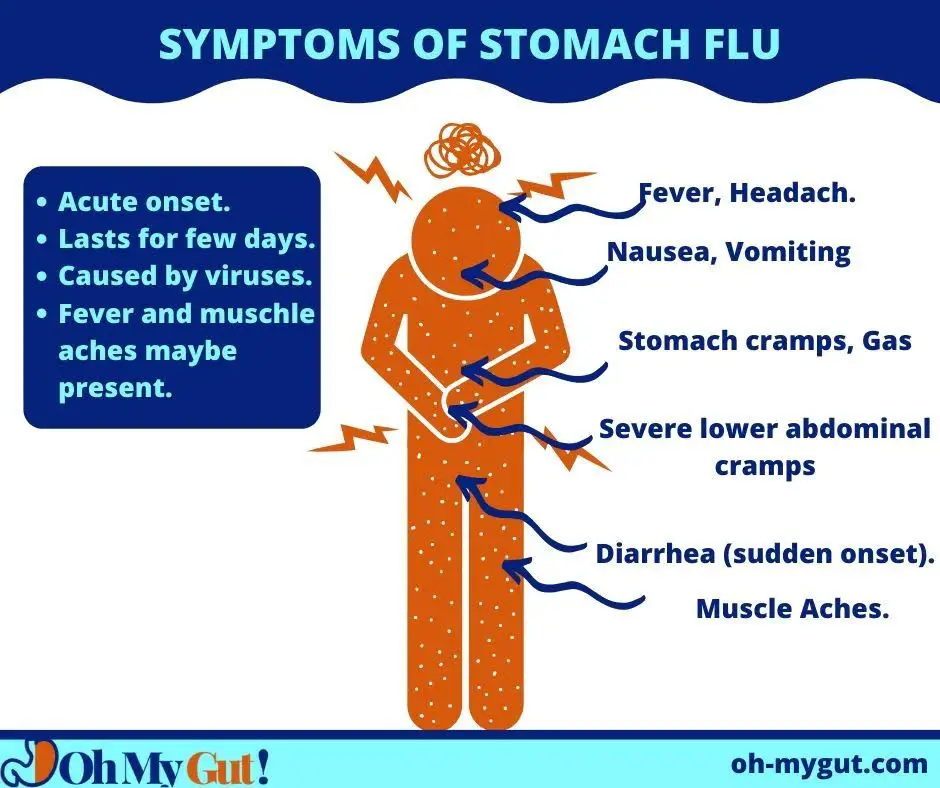Abdominal Pain & Vomiting Without Fever.
Our content is not intended nor recommended as a substitute for medical advice by your doctor. Use for informational purposes only.
Abdominal pain and vomiting can be due to several conditions. Acute abdominal pain and nausea are most commonly due to stomach bugs (Commonly due to viral gastroenteritis).
Chronic abdominal pain or recurrent abdominal pain and vomiting can be due to several conditions such as chronic gastritis, peptic ulcer disease, GERD, or gallbladder diseases.
1 . Viral Gastroenteritis (stomach flu).
Acute viral gastroenteritis is also called stomach flu. It is the most common cause of acute infectious diarrhea.
The most common causes are Rotavirus and norovirus. Rotavirus is the most common cause of viral gastroenteritis worldwide (reference). However, The introduction of the rota vaccine (as in the USA) made the virus less prevalent.
Symptoms:
- Acute onset of severe non-stop diarrhea (usually watery and yellow).
- Diarrhea usually lasts for a few days (2-5 days) but may last longer.
- Abdominal cramps (usually at the lower abdomen).
- Anorexia (loss of appetite).
- Nausea or vomiting.
- Fever is usually present (often of low grade). The fever may be unnoticeable (only a cold sensation or sense of fatigue or muscle aches).

2. Food poisoning and other infections.
A. Bacterial Gastroenteritis.
Bacteria leads to a more severe form of diarrhea. The most prevalent organisms that cause bacterial gastroenteritis include (reference):
- Salmonella species (typhoid fever).
- Clostridium perfringens (foodborne).
- Campylobacter species.
- Staphylococcal aureus (foodborne).
- E. Coli species.
Most cases of bacterial gastroenteritis (GE) are foodborne. Bacterial gastroenteritis is the most frequent cause of food poisoning.
The symptoms are typically more severe than viral gastroenteritis:
- The diarrhea is severe, non-stop.
- Bloody and mucoid diarrhea are common.
- Tenesmus (an urge to poop, but only mucus or scanty stool comes out).
- Fever is high grade.
- Vomiting is more common and severe.
- More severe systemic illness (headache, fatigue, muscle aches, and dizziness).
B. Protozoal & other types of gastroenteritis.
Parasites can also cause severe forms of non-stop diarrhea. The most common organisms are:
- Toxoplasma Gondii.
- Giardiasis
- Cryptosporidium species.
- Entamoeba Histolytica (causes dysentery rather than diarrhea).
The symptoms of protozoal infections are similar to that of viral diarrhea. Giardiasis can cause a severe form of non-stop diarrhea. It can cause fat malabsorption, yellow diarrhea, fever, and vomiting. Learn More.
3. Gastritis.
Gastritis is the inflammation of your stomach wall. Acute and chronic gastritis are the most common causes of sharp upper stomach pain.
gastritis is commonly caused by:
- Faulty diet habits: such as spicy, high fat, alocholo, caffeine, and acidic foods.
- NSAIDs abuse: such as Aspirin, Ibuprofen, and Diclofenac.
- H. Pylori infection: a stomach bug that causes gastritis and stomach ulcers.
- Acute gastritis (due to stomach flu): is usually caused by stomach viruses such as norovirus and rotavirus, causing sharp upper and lower stomach pain and diarrhea.
Symptoms (How to suspect Gastritis):
- The Upper stomach pain is sharp, continuous, in the form of heaviness or gnawing.
- Related to meals: the pain usually starts shortly after meals (especially heavy or fatty meals).
- The pain can be referred to as the upper-middle back.
- Associated with nausea, lost appetite, or vomiting.
- In severe cases, an ulcer can occur (peptic ulcer).
- Gastritis can be chronic (the pain comes and goes for long periods) or acute (with sudden sharp upper abdominal pain).
- The most common cause of acute gastritis is NSAID drugs and infection with stomach viruses (Norovirus and rotavirus).
4. Peptic ulcer disease.
A peptic ulcer is a breakdown in the lining of your stomach (stomach ulcer) or duodenum (duodenal ulcer).
Peptic ulcer disease is a complication of gastritis. It shares the same causes and symptoms of gastritis plus:
- The upper stomach pain is usually sharper and more severe.
- Nausea and vomiting are more common.
- Bleeding ulcers can lead to vomiting of blood (hematemesis).
- Bleeding can also occur without vomiting blood. The presentation may be dark tarry stools (melena).
- Also, the bleeding can be scanty over long periods. This leads to anemia (with fatigue, dizziness, and shortness of breath).
CAUTION: A bleeding peptic ulcer is a medical emergency. Call your doctor immediately if you vomit blood or pass black stools with sharp upper stomach pain.
5. Gallbladder conditions.
| Biliary colic (Uncomplicated gallstone). | Description |
| 1. Site | Usually, The right upper quadrant of your abdomen |
| 2. Spread | – The pain may spread to the back of the right shoulder. – Also, it spreads to the epigastric area. |
| 3. Character | Constant builds up then disappears gradually. |
| 4. Duration | At least 30 minutes. It may last up to 6 hours. |
| 5. Relation to food | – Triggered by foods (especially fatty food and large meals. – However, it can start spontaneously. |
| 6. NOT related to: | Movement, bowel movements, or the passage of flatus. |
| 7. Nausea | Often Present, severe. |
| 8- Commonly associated symptoms | Vomiting, sweating during the attack. |
| 9. Unusual symptoms. | – Heartburn and chest pain. – Bloating, fullness. – Early satiety. – Isolated epigastric pain. |
| 10. Symptoms NOT associated: | – Fever. – Jaundice. – Prolonged pain for more than 6 hours. – Extreme tenderness over the gallbladder (Murphy’s sign). – Vomiting of blood, blackish stool (PUD). |
6. Medications.
The following are medications that may cause abdominal pain and vomiting without fever:
- Non-steroidal anti-inflammatory drugs such as ibuprofen and aspirin (Paracetamol or Tylenol® is the least likely NSAID to cause vomiting and abdominal pain).
- Cancer chemotherapy.
- Anti-gout drugs.
- Heart medications such as digoxin, anti-hypertensives, and beta-blockers.
- Diuretics (medications that increase urine): they are used to treat excess fluid in your body, as with heart failure, liver, and kidney diseases.
- Some antibiotics as erythromycin, sulfonamides, etc.
- Sulfasalazine.
- Nervous system medications such as antiseizure and antiparkinson drugs.
- Overdose of vitamin supplements.
7. Others:
- Pancreatitis
- GERD and hiatal hernia
- Gastric outlet obstruction and adult pylori stenosis.
- Intra-abdominal tumors
- Diabetic gastroparesis
- Diabetic ketoacidosis
- Kidney stones
- Acute renal failure
- Intestinal obstruction
- Acute hepatitis
- Migraine
- Extremely painful conditions
- Early pregnancy
- Endocrinal diseases such as hyperparathyroidism, hyperthyroidism, and Addison’s diseases
- Acute intermittent porphyria
- Post-operative abdominal pain and vomiting
- Heart attack (acute coronary syndrome)
- Familial Mediterranean fever
- Hypervitaminosis (excess vitamin supplementation).
- Evidence-based
- Written by a doctor.

Related Posts:
- 5 Main causes of abdominal pain and blood in the urine
- 5 Causes of Lower Abdominal Pain When Coughing &…
- Can Vomiting Blood Cause Death? Doctor Explains.
- 8 Tips To Avoid Vomiting & Nausea During Colonoscopy…
- Pooping mucus only: 12 Causes Explained (Dr. Farahat).
- Liver Pain in Females: Location, Causes, Pregnancy, & More.





